On A Quest For A Freshwater Giant: Alligator Gar On The Escambia River
March 26, 2015
The quest is on to find one of Florida’s most mysterious fish with a prehistoric look in the Escambia River.
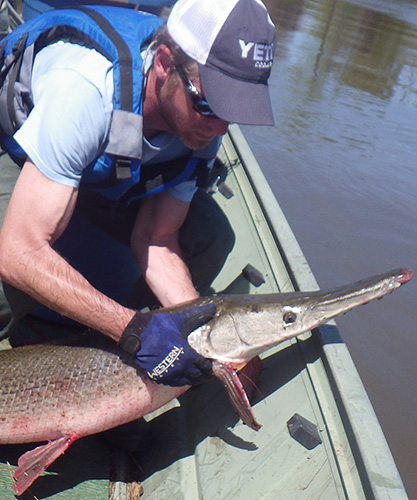 Finding alligator gar can be a challenge, but it’s one biologists with the Fish and Wildlife Research Institute are taking on to learn more about the population of the fish in Florida.
Finding alligator gar can be a challenge, but it’s one biologists with the Fish and Wildlife Research Institute are taking on to learn more about the population of the fish in Florida.
Alligator gar have historically resided in rivers and brackish waters throughout the southeastern U.S. from the Florida Panhandle – from the Apalachicola River west to the Perdido River – to Texas and Mexico. Since the mid-1900s, alligator gar numbers have declined, leaving populations in only half of the 14 states they once inhabited. The FWC acknowledged this in 2006, prohibiting harvest of alligator gar for all but scientific purposes.
Since 2010, FWRI researchers have been tagging alligator gar in the Escambia River to learn more about their movement and habitat use. Using large-mesh gill nets, researchers collect adult alligator gar and fit them with telemetry tags before releasing them back into the river. These tags transmit information through radio and sound signals, allowing researchers to track each individual’s location for about two years.
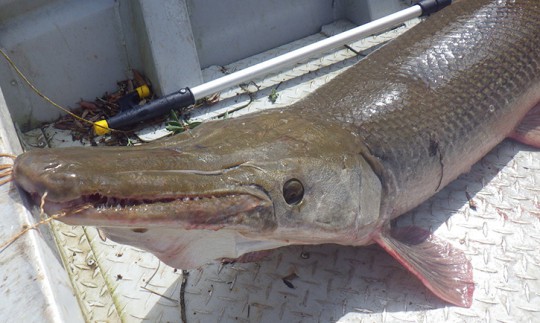 Three years into the study, researchers have tagged 22 alligator gar ranging from 11 pounds to a state record 132 pounds; tagged fish average 60 pounds. Researchers are trying to identify what habitats these fish prefer, how far they travel and whether they return to the same location over time. Preliminary tracking data indicate alligator gar are highly mobile and can travel more than 40 miles in a single week.
Three years into the study, researchers have tagged 22 alligator gar ranging from 11 pounds to a state record 132 pounds; tagged fish average 60 pounds. Researchers are trying to identify what habitats these fish prefer, how far they travel and whether they return to the same location over time. Preliminary tracking data indicate alligator gar are highly mobile and can travel more than 40 miles in a single week.
The data also reveal their movement and habitat use varies by season. In winter, the tagged fish tend to reside in a slough – a cove off the main river with no current – and move very little. As the season changes to spring, they begin traveling the river’s main channel but return repeatedly to the slough. Only in late spring did the gar venture from their home-base slough and begin cruising. Biologists recorded alligator gar moving as far north as Century and the Alabama state line and as far south as Escambia Bay during this time.
No population data for alligator gar in Florida currently exists. However, data from this tagging study are helping biologists develop a strategy for estimating the population size of alligator gar, first in the Escambia River, then possibly in other rivers in northwest Florida’s coastal plain.
Pictured: Alligator gar research on the Escambia River. Photos for NorthEscambia.com, click to enlarge.
Comments
8 Responses to “On A Quest For A Freshwater Giant: Alligator Gar On The Escambia River”



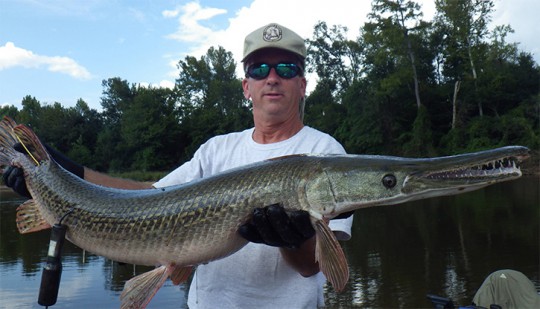
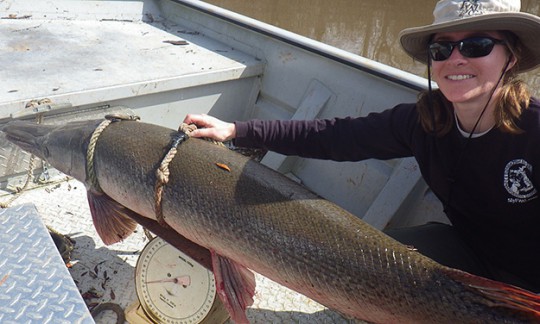
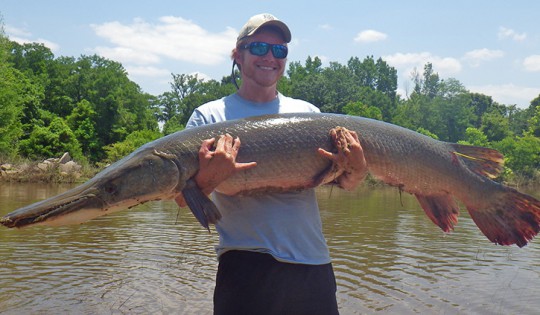
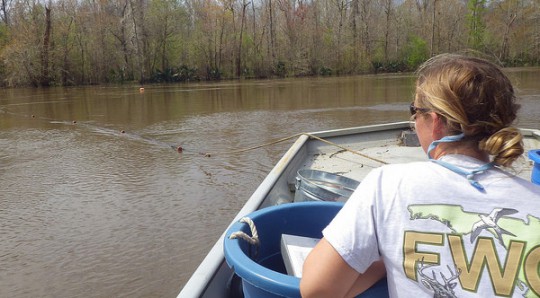
i used to love catching these when I was a kid. There’s a resident far in the little fishing hole behind the damn at Lake Stone if anybody wants to check one out.
REGARDING:
“Can/do they eat humans???”
Per Wiki:
They are opportunistic night predators and are primarily piscivores (they eat other fish), but they will also ambush and eat water fowl and small mammals (not humans, think mice, rats, rabbits dhg) that may be floating on the surface. Their method of ambush is to float a few feet below the surface, and wait for unsuspecting prey to swim within reach.
Diet studies have shown alligator gars to be opportunistic piscivores, and even scavengers depending on the availability of their preferred food source. They occasionally ingest sport fishes, but the majority of stomach content studies suggest they feed predominately on forage fishes such as gizzard shad as well as invertebrates, and water fowl. Diet studies have also revealed fishing tackle and boat engine parts in their stomachs (probably small parts dhg)
@Mary
They prefer them with rice.
Can/do they eat humans???
I have seen many of these on Perdido and Escambia rivers,but definitely not the size shown here .
Has a study ever been done on the yearly gar migration on the Perdido River?
About 2 years years ago I was fishing from shore at a secret spot in Escambia Bay just south of Creighton. I was using live finger mullet in the 4″ range and hooked one of these. Kind of freaked me out when I got it to shore and saw what it was.
Took a few pics, unhooked it, (Very carefully) and safely released it. It was 3′-4′ long and more docile than I would have expected.
Some nice gars there!